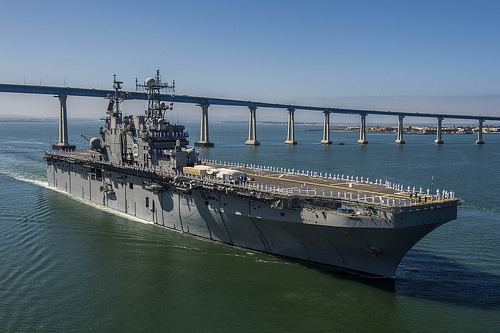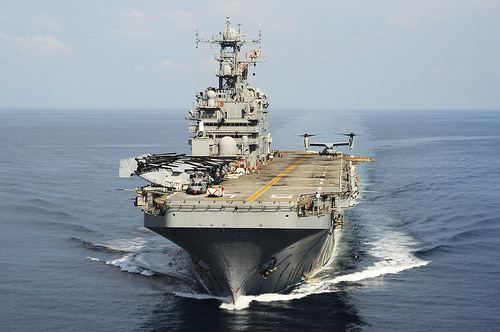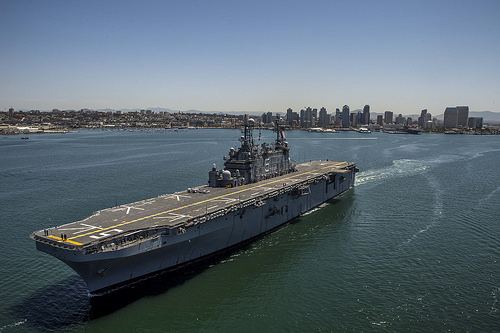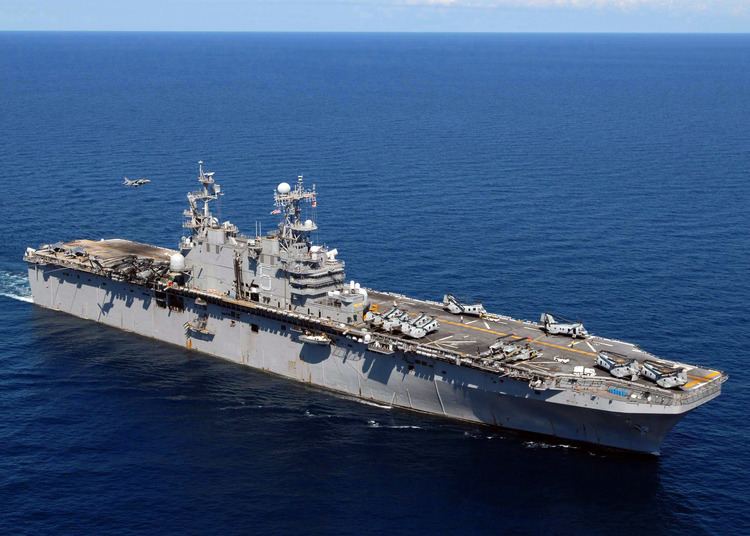Name USS Peleliu Ordered 6 November 1970 Commissioned 3 May 1980 Length 250 m Launched 25 November 1978 Builder Ingalls Shipbuilding | Namesake Battle of Peleliu Laid down 12 November 1976 Decommissioned 31 March 2015 Construction started 12 November 1976 Beam 32 m | |
 | ||
Uss peleliu lha 5 leaving san diego 05 07 2012
USS Peleliu (LHA-5) was a Tarawa-class amphibious assault ship of the United States Navy, named for the Battle of Peleliu of World War II. Entering service in 1980, she has been deployed to the Persian Gulf on several occasions, performed an evacuation of U.S. Naval Base Subic Bay following the eruption of Mount Pinatubo, operated with the INTERFET peacekeeping taskforce, participated in Pacific Partnership deployments, and provided assistance following the massive floods in Pakistan in 2010. She was decommissioned in San Diego, California on March 31, 2015. She will rest in Pearl Harbor, Hawaii alongside USS Tarawa in the inactive reserve in case of further need.
Contents
- Uss peleliu lha 5 leaving san diego 05 07 2012
- Executive officer aboard tarawa class amphibious assault ship uss peleliu lha 5
- Design and construction
- Operational history
- Ships Coat of Arms
- In fiction
- References

Executive officer aboard tarawa class amphibious assault ship uss peleliu lha 5
Design and construction

Peleliu was originally going to be named USS Khe Sanh, and then USS Da Nang. Peleliu's keel was laid down in 1976 at the Litton Industries Ingalls Shipbuilding company in Pascagoula, Mississippi. She was launched on 25 November 1978, sponsored by Peggy Hayward, the wife of the Chief of Naval Operations at that time, Admiral Thomas B. Hayward. Peleliu was commissioned on 3 May 1980, with Captain T. P. Scott in command.
Operational history

Peleliu immediately steamed southwards, and then she transited the Panama Canal to the Pacific Ocean. She crossed the Equator for the first time on 27 May 1980, setting a new record for time between an American warship's commissioning and her crossing over into the Southern Hemisphere. Next, Peleliu steamed to the seaport of Long Beach, California.

Following the 17 October 1989 San Francisco earthquake, Peleliu was one of the 24 U.S. Navy and Military Sealift Command ships that rendered assistance. Peleliu provided shelter for 300 victims and provided helicopter support.

Peleliu deployed again to the Western Pacific in January 1990. The ship, along with her Amphibious Ready Group (ARG), participated in multinational exercises including Exercise Team Spirit with forces from the Republic of Korea, and Exercise Cobra Gold, in Thailand. Peleliu returned home to Naval Station Long Beach in July and later that summer entered the shipyard for an availability period that was scheduled to last nearly a year. The U.S. response to the Iraqi invasion of Kuwait in August 1990 curtailed the shipyard availability and forced Peleliu into an accelerated schedule of pre-deployment training, but she did not deploy for Operation Desert Shield/Desert Storm. She eventually departed Long Beach in May, 1991, in support of ongoing U.S. operations in the Middle East. In June 1991, while en route to the Persian Gulf, Peleliu was diverted from a scheduled port call in Hong Kong to the Philippines, where she participated in the evacuation of the Americans from the U.S. Naval Base Subic Bay following the volcanic eruption of Mount Pinatubo. This evacuation included taking most of the patients from the maternity ward at the Subic Bay naval hospital, and hence there were several births on board Peleliu. This eruption was one of the largest eruptions of the past 100 years and covered a large region of the Philippines in volcanic ash and caused extensive damage to American military bases in the area, including Naval Station Subic Bay, Naval Air Station Cubi Point, and Clark Air Force Base.
On returning to her home port at Long Beach Naval Shipyard, Peleliu went through an extensive shipyard rehabilitation, including time in the dry dock. She was again underway by May 1992 and going through workups and inspections for her next Western Pacific (WESTPAC) deployment on 21 January 1994. She changed home ports to Naval Station, San Diego during this time period as well. On deploying with members of the 11th Marine Expeditionary Unit, and following stops in Pearl Harbor and Singapore, she steamed for Mogadishu, Somalia to participate in Operation Continue Hope and Operation Quick Draw. VIP visits included Chairman, Joint Chiefs of Staff General John Shalikashvili, COMPHIBGRU THREE, Rear Admiral James B. Perkins III, and CJTF Major General Thomas M. Montgomery, U.S. Army. Brig. General Vercauteren, USMC, visited with his deployed Marines as well. While off the coast of Mombasa, she participated in Operation Distant Runner at the border of Rwanda and Burundi. Medical and Dental Civic Action Programs(MEDCAP, DENCAP) were performed in the villages of Kipini and Witu, Kenya, providing medical and dental services to local civilians. Leaving Somalia on 25 March 1994, she steamed to Perth, Australia for a port visit. On 30 June 1994, Peleliu slowed her pace home and along with ship's company, Marines of 2nd Battalion 5th Marines, paused to honor the fallen off the coast of her name sake Peleliu, where 50 years earlier the Marines of the 1st Marine Division suffered 6,526 casualties with 1,256 killed in action against 10,138 Japanese defenders of which very few were taken alive in the Battle of Peleliu.
Peleliu was deployed to East Timor as part of the Australian-led INTERFET peacekeeping task force from 26 October to 27 November 1999.
Peleliu departed from San Diego in August 2001 with the 15th Marine Expeditionary Unit on board for a routine six-month deployment in the Western Pacific. She was in the port of Darwin, Australia during the September 11 attacks. Following those attacks, Peleliu was sent to the North Arabian Sea and, on 26 November 2001, she took the first U.S. Marines to Afghanistan as part of Operation Enduring Freedom. After the American Taliban John Walker Lindh was captured in Afghanistan, he was sent to Peleliu on 14 December 2001. There he was interrogated by a U.S. Marine Corps intelligence team. While he was on board Peleliu, Lindh signed confessions and he told his interrogators that he was not merely a member of the Taliban, but a full member of Al Qaeda.
Lindh received surgery by the senior surgeon of Peleliu to remove a bullet in his leg, and he was also treated for frostbite on his toes.
While on deployment in support of Operation Iraqi Freedom, in 2004, and as flagship of Expeditionary Strike Group One, a hostile boat was intercepted by warships at sea in the Indian Ocean, and 15 people were detained. An estimated 2,800 pounds (1,300 kg) of hashish was seized by American and Australian warships after the interception of the boat in the North Arabian Sea. During this deployment Peleliu was deployed for nine months and supported air strikes into Iraq. Marines from the embarked Marine Expeditionary Unit participated in ground operations in southern Iraq.
Peleliu steamed to support of the Pacific Partnership mission from 23 May through 20 September 2007. This mission included medical, dental, construction, and other humanitarian assistance programs on shore and afloat in the Philippines, Vietnam, Papua New Guinea, the Solomon Islands, and the Marshall Islands. The medical personnel on board Peleliu included teams from the U.S. Navy and ten other countries, and also from three private assistance organizations.
In 2008, Peleliu was sent to the Indian Ocean to support Operation Iraqi Freedom, Operation Enduring Freedom, and antipiracy operations. On 10 August 2008, Peleliu responded to a distress call from a merchant ship, Gem of Kilakari, that was being attacked by armed pirates in the Gulf of Aden. That pirate attack was put to an end with no injuries.
In August 2010, Peleliu was sent to Port of Karachi, Pakistan, to use 19 of her helicopters for rescues during the massive floods in southern Pakistan, which were the worst one in the (very long) recorded history of Pakistan. During this deployment, Captain David Schnell, the commanding officer of Peleliu, was relieved of his command and reassigned for being "unduly familiar" with several crewmembers.
Captain Mark E. Cedrun, the chief of staff for Expeditionary Strike Group 3, replaced Captain Schnell as the commanding officer of Peleliu.
On 24 November 2010, Peleliu returned full circle and she was berthed in the Subic Bay Freeport Zone on her first visit there since the evacuation by the Navy in 1991. That deployment also included port visits to: Naval Base Guam, Apra Harbor, Guam; Darwin, Australia; Dubai, UAE; Phuket, Thailand; and Pearl Harbor, Hawai'i before returning to its home port in San Diego, California on 18 Dec 2010.
On 17 September 2012, Peleliu deployed to the C5F AOR under the command of Captain John D. Deehr
On 14 May 2013, Peleliu returned to its homeport after an eight-month deployment, accompanied by the USS Green Bay (LPD-20) and the USS Rushmore (LSD-47).
In February 2014, the United States Pacific Fleet announced that USS Green Bay would be forward deployed to replace the decommissioned USS Denver in Japan. Peleliu deployed to the Western Pacific to mitigate the gap in amphibious presence. The ship visited numerous ports including, Apra Harbor, Guam; Sasebo and Okinawa, Japan; Subic Bay, Philippines and Singapore. During the visits, Peleliu competed against partner nation teams during various sporting events and participated in community relations projects.
Over the course of deployment, Peleliu transited more than 25,000 nautical miles (46,000 km; 29,000 mi), conducted the safe launch and recovery of more than 50 Landing Craft Utility, 30 Landing Craft Air Cushion, and 25 Amphibious Assault Vehicle ship to shore movements, as well as carrier and deck landing qualifications and operations for U.S. Navy and Marine Corps aircraft squadrons, U.S. Army 160th Special Operations Aviation Regiment (Airborne) and foreign aircraft from Colombia, Peru, Mexico and Argentina.
Peleliu returned to Naval Base San Diego on 24 December 2014 from its final six-month deployment to the Western Pacific. The ship had left San Diego on 17 June. Upon return, the ship made preparations to decommission in March 2015 after 34 years of service, 17 deployments and more than a 1.6 million kilometres transited. During the ship's deployment Peleliu, its crew, Commander, Amphibious Squadron Three, Special Purpose Marine Task Force Three and Helicopter Sea Combat Squadron (HSC) 21 participated in Rim of the Pacific (RIMPAC) 2014 as part of the United States Third Fleet. Upon assignment to United States Seventh Fleet, the ship embarked Commander, Amphibious Force Seventh Fleet, Commander, Amphibious Squadron 11 and 31st Marine Expeditionary Unit and joined USS Germantown to form the Peleliu Amphibious Readiness Group (ARG). While deployed, the ARG conducted security and stability operations and exercises throughout the Indo-Asia-Pacific region to include Amphibious Landing Exercise (PHIBLEX) 15 and other maritime cooperation exercises with partner nations.
Peleliu was decommissioned on 31 March 2015 in San Diego. Following its decommissioning, the 820 ft-long vessel will be towed to Pearl Harbor to join the reserve fleet, where it will be placed in an inactive reserve status and moored alongside her sister ship Tarawa.
Ship's Coat of Arms
The stars across the top of the shield represent the eight Medal of Honor recipients from the Battle of Peleliu Island in 1944. Centered is the large Roman numeral "V", which represents the hull number of the ship, LHA-5. The four-point star in the "V" identifies the four functions of the landing force, and sustain their operations ashore. In the lower left-hand side of the shield is a ring, which by tradition of heraldry, symbolizes the fifth born. The 1st Marine Division emblem is the constellation Southern Cross with the numeral '1' superimposed.
Retired Navy Chief DSC William J. Cunningham, a plankowner, was the primary designer of the Ship's Coat of Arms contributing all design work except the four-point star during pre-com in 1979.
In fiction
Peleliu figures prominently in M. L. Buchman's Night Stalkers novel series including: Light Up the Night, Bring On the Dusk, and Christmas at Steel Beach.
